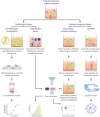Expanding Role of T Cells in Human Autoimmune Diseases of the Central Nervous System
- PMID: 28638382
- PMCID: PMC5461350
- DOI: 10.3389/fimmu.2017.00652
Expanding Role of T Cells in Human Autoimmune Diseases of the Central Nervous System
Abstract
It is being increasingly recognized that a dysregulation of the immune system plays a vital role in neurological disorders and shapes the treatment of the disease. Aberrant T cell responses, in particular, are key in driving autoimmunity and have been traditionally associated with multiple sclerosis. Yet, it is evident that there are other neurological diseases in which autoreactive T cells have an active role in pathogenesis. In this review, we report on the recent progress in profiling and assessing the functionality of autoreactive T cells in central nervous system (CNS) autoimmune disorders that are currently postulated to be primarily T cell driven. We also explore the autoreactive T cell response in a recently emerging group of syndromes characterized by autoantibodies against neuronal cell-surface proteins. Common methodology implemented in T cell biology is further considered as it is an important determinant in their detection and characterization. An improved understanding of the contribution of autoreactive T cells expands our knowledge of the autoimmune response in CNS disorders and can offer novel methods of therapeutic intervention.
Keywords: T cell detection; autoantibodies; autoreactive T cells; central nervous system autoimmune diseases; multiple sclerosis; neuroimmunology.
Figures


References
Publication types
LinkOut - more resources
Full Text Sources
Other Literature Sources

